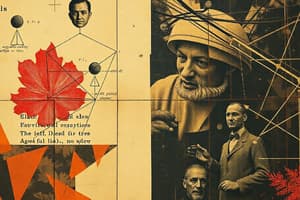Podcast
Questions and Answers
Who is credited with inventing the incandescent light bulb?
Who is credited with inventing the incandescent light bulb?
- Nikola Tesla
- Albert Einstein
- Thomas Edison (correct)
- Marie Curie
Which scientist is associated with alternating current systems?
Which scientist is associated with alternating current systems?
- Albert Einstein
- Thomas Edison
- Marie Curie
- Nikola Tesla (correct)
What technological possibilities were ushered in by advancements in electromagnetic energy?
What technological possibilities were ushered in by advancements in electromagnetic energy?
- Improved agricultural techniques
- Innovations in fashion design
- Breakthroughs in space exploration (correct)
- Advancements in culinary arts
What are some areas that demand innovative responses from both theorists and experimentalists in electromagnetism?
What are some areas that demand innovative responses from both theorists and experimentalists in electromagnetism?
What role can students and graduates take up to gain hands-on experience in electromagnetism research?
What role can students and graduates take up to gain hands-on experience in electromagnetism research?
What is the central concept that governs the interplay between electricity and magnetism in electromagnetism?
What is the central concept that governs the interplay between electricity and magnetism in electromagnetism?
Which physics concept describes the relationship between electric charge distribution, electric and magnetic fields?
Which physics concept describes the relationship between electric charge distribution, electric and magnetic fields?
What is the elementary illustration of electromagnetism involving attraction between the north and south poles of a magnet?
What is the elementary illustration of electromagnetism involving attraction between the north and south poles of a magnet?
Which physics law quantifies electrostatic attraction and repulsion between stationary charges?
Which physics law quantifies electrostatic attraction and repulsion between stationary charges?
What demonstrates how changes in electric or magnetic fields lead to voltage generation or motion of charges?
What demonstrates how changes in electric or magnetic fields lead to voltage generation or motion of charges?
Which concept helps measure magnetic field strengths?
Which concept helps measure magnetic field strengths?
Flashcards are hidden until you start studying
Study Notes
Mastering Electromagnetism: A Pillar of Modern Physics
Electromagnetism represents a pivotal chapter in our understanding of nature's forces, shaping countless innovations since its discovery. Central to this phenomenon lies the interplay between electricity and magnetism, governed by Maxwell's Equations, which encapsulate James Clerk Maxwell's landmark contributions to physics.
Maxwell's Equations describe the relationship between electric charge distribution, electric and magnetic fields, and their sources. These equations have led to groundbreaking inventions such as radio communication, satellites, computers, and LED lighting, to name only a fraction of their far-ranging impacts.
Magnetic Forces Explained
An elementary illustration of electromagnetism can be seen in a simple bar magnet, whose north pole attracts the south pole of another magnet. Magnets generate a magnetic field encompassing charged particles, guiding them along invisible lines of force.
Inside conductive materials, moving charges produce their own magnetic fields, creating electrical motors, generators, and transformers. Induced magnetic effects, such as Faraday's Law, demonstrate how changes in electric or magnetic fields lead to voltage generation or motion of charges via Lenz's law.
Measuring Charge and Field Strength
Coulomb's Law quantifies electrostatic attraction and repulsion between stationary charges, while Gauss's Flux Theorem helps measure magnetic field strengths. Edison's incandescent light bulb, Tesla's alternating current systems, and Einstein's photoelectric effect further advanced our understanding of electromagnetic energy, ushering in a new era of technological possibilities.
Research Opportunities
For aspiring physicists seeking careers in academia, industry, or government labs, research ventures abound across various subfields of electromagnetism. Students and graduates alike may pursue research as a Graduate Research Assistant (GRA), offering hands-on experience in diverse settings and collaborations with renowned experts worldwide.
As technology advances, electromagnetism continues evolving to meet emerging needs in medicine, space exploration, environmental monitoring, sustainable energy production, and quantum computing—all of which demand innovative responses from both theorists and experimentalists.
Studying That Suits You
Use AI to generate personalized quizzes and flashcards to suit your learning preferences.





